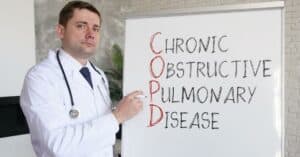A few things to remember when you just don’t feel like cooking.
Chronic obstructive pulmonary disease (COPD), is a degenerative lung disease that slowly wears away a patient’s breathing ability and quality of life.
Although difficulty breathing can often be the biggest concern for this group, the day-to-day fatigue that comes with it can be a symptom that is often under-represented.
For those who live with COPD, the routine errands and chores that may be normal for others, can be extremely difficult for those battling respiratory disease.
Every step for someone living with COPD, may feel like 10 steps up a flight of stairs for those healthier. And with these key differences in mobility and daily exertion, the simplest tasks can prove to be next to impossible without assistance.
As a human being, we derive our body’s daily vitamins, nutrients, and energy from the foods we consume.
However, when faced with daily fatigue, a lack of mobility, and a sense that even the most fundamental tasks are a practice of over-exerting oneself, getting the body’s necessary requirements can become increasingly difficult as the disease progresses.
So, how do you gain your body’s recommended nutritional intake when getting up to cook feels impossible?
You eat out.
With your health in mind, the Lung Institute is here to break down Eating Out with COPD: 4 Tips for Living and Breathing Easier.
4. Stay Local or Order In
When it comes to eating out with COPD, it’s best to eat locally. In general, travel—particularly driving—can be difficult for many with respiratory illnesses.
From difficulties using or storing an oxygen tank in the car, to the tangible effects of fatigue (blurred vision, slowed reaction) that can come from being short of breath, driving with COPD can be a dangerous combination in the worst conditions.
To remedy this situation, limit your range of food options to only a few miles or so. Depending on where you live, you’d be surprised how far 2-3 miles in any direction will take you as far as choices to eat.
When looking for good food in the area, try using Google and type in “[type of cuisine] near me” (“Italian near me” for example), and it will generate your communities leading restaurants in that field.
By staying local, you will be supporting local businesses and keeping your drives short and at a minimal distance. Order food in if driving seems too much of a bother. There are a variety of computer apps that can be applied to your phone such as UberEats, Grubhub, or Seamless.
Speaking of Uber…
3. Catch a Ride
As we’ve mentioned above, driving to eat isn’t always the preferred option if you’re experiencing increased fatigue and a lack of mobility.
When in doubt, but still hungry, call a friend, spouse, or loved one to go out to eat, or if they’re particularly understanding maybe they will bring you something.
Going out to eat with a friend or loved one creates an opportunity to enhance that relationship while removing your responsibility for having to drive.
If you haven’t sat down and had lunch with a friend in a while, call them up and catch up. If you haven’t had a nice dinner with your spouse, find a restaurant around the corner and try it.
And in the case that your spouse, loved one, or friend is unavailable, download the Uber app on your phone and use it as your own personally taxi.
Eating alone can be an incredible experience, especially if you’ve got a good book.
2. Understand Nutrition and Daily Vitamins
Understanding nutrition can be difficult for the uninitiated. What does trans fat mean and is it good or bad? How many grams of sugar is too much?
Although there are people who study nutrition for a living, understanding the basics to improve your health can be simpler than you think.
So, as a general rule:
Eat foods that are as close to their original form as possible.
What does this mean?
It means to avoid eating processed (foods that have been overly treated with preservatives, frozen, etc.) and instead eat fresh and naturally produced foods.
This can mean organic to some, but in general, rather than eating that fast-food burger, grab a container of ground beef from the store. Rather than buffalo wings at the sports bar, bake some parmesan-crusted wings in the oven.
Increase your fruit intake, your vegetables (even more important as they contain less sugar) and eat breads and grains that haven’t been processed (whole wheat bread vs white bread).
Although these nutritional changes can feel like a lot at first, you’ll notice immediately how much better your body processes natural foods and the nutrients within them than processed foods that have had their nutrients stripped.
1. Eat Small and Raw
By eating small, this means reducing the traditionally large portion sizes of American cuisine into smaller amounts.
The problem with typical American eating habits is the fact that when we see our plates piled high (specifically around Thanksgiving), we assume that we must finish it, rather than reflecting on whether we should.
Try to focus on light meals to tackle better nutrition when eating out. This would mean fish in comparison to beef. Chicken in comparison to pork.
When referring to “raw” foods, this simply means foods that can be pulled directly from the Earth with zero processing.
This could mean a fresh-picked batch of strawberries, almonds, or spinach.
By thinking in terms of food and the natural energy it contains, the better the food source (the best source is the Earth), the better you will feel as a result of eating it.
So, the next time you’re dining in a new restaurant or ordering take-out, consider the food’s quality and ingredients. The food you eat should be as fresh as possible; always.
What Can I Do Next?
Without question, changing your eating habits is one of the top things you can do to better your health today. The next step is quitting smoking if you haven’t already.
Although we always recommend quitting smoking first as a crucial step to better health, addressing your general health through simple diet and exercise is equally important.
These behavioral changes can greatly affect the pronouncement of symptoms within those with COPD, emphysema and pulmonary fibrosis.

Christine Kingsley, APRN is the Health and Wellness Director at the Lung Institute where she focuses on providing helpful online resources for people looking for information on various lung diseases, breathing exercises, and healthy lifestyle choices. She advocates for holistic care that involves working with your doctor to explore all options including traditional and alternative care while focusing on diet and exercise as proactive measures.









